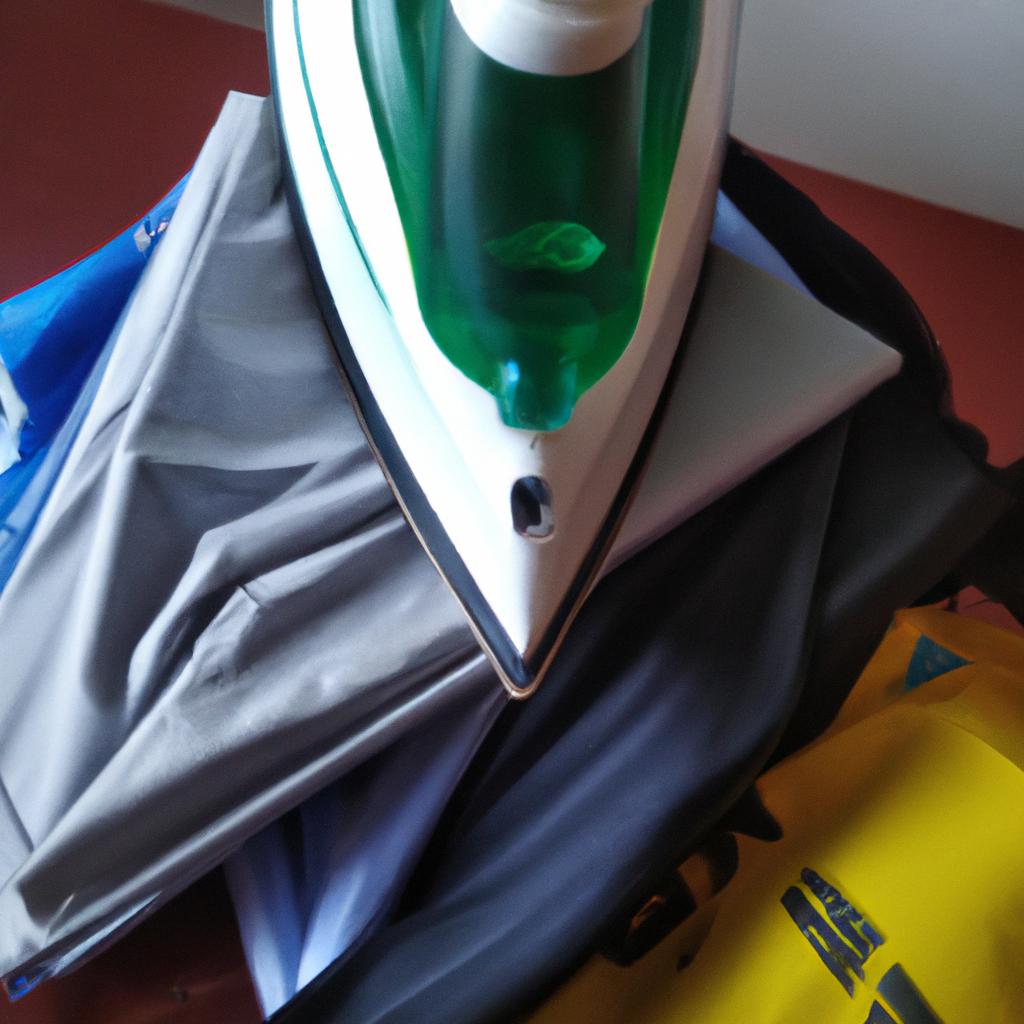Are you looking to spruce up your nylon bags? Ironing on patches and designs is an easy way to do just that!
But before you get started, it’s important to know if you can safely iron onto a nylon bag. As an outdoor expert, I’m here to tell you all the details of how this task should be approached.
Ironing onto nylon demands extra attention when compared with other materials. Heat needs to be applied differently; otherwise, the material could become damaged or discolored.
With the right information at hand though, there’s no reason why you can’t enjoy adding some personal touches to your gear for heightened freedom of expression!
Properties Of Nylon

Nylon is like a superhero for outdoor adventurers. It’s heat resistant, wrinkle free, water repellent, lightweight and breathable – all the qualities that make it an ideal fabric for active lifestyles.
Whether you’re heading to the beach or out into nature, nylon can help protect you from the elements while keeping your look stylish and put together.
It’s no wonder why so many people turn to this versatile material when they need something durable but also comfortable enough to wear in any situation.
Plus, with its natural resistance to wrinkles and stains, there’s no worry about having to carry around an iron or steamer everywhere you go!
However, if you do want to keep your nylon items looking crisp and clean without compromising their strength and shape, then it’s important to know how best to apply some heat.
Best Practices For Ironing Nylon
When it comes to ironing nylon, choosing the right iron and setting the temperature correctly are key. I’m here to provide you with all the info you need to iron nylon safely and effectively.
Choosing An Iron
When it comes to ironing nylon bags, you want the right tool for the job. It’s all about finding an iron that has adjustable heat settings and is suitable for a variety of fabric types – from delicate silk to sturdy nylon.
To ensure your bag looks its best, always use a press cloth between the bag material and the iron plate; this will protect against scorching or sticking.
With some trial-and-error on a scrap piece of fabric, you’ll quickly find the ideal heat setting for each type of fabric you work with.
By investing in a good quality iron, you can get great results every time without any added stress or frustration.
So go ahead: give yourself freedom by taking control of your garment care routine!
Setting The Temperature
Now that we have the right iron for the job, let’s talk about setting the temperature.
The heat application should be tailored to each fabric type you’re working with – from delicate silk to thick nylon.
To ensure a safe and successful outcome, it’s important to pay attention to what kind of fabric you’re using and select accordingly;
this will minimize any risk of scorching or damage to your garments.
Heat safety is also essential – make sure not to exceed the manufacturer’s recommended settings!
With all these tips in mind, you can easily dial in the perfect temperature for whatever material you may need to press.
So go ahead: grab your iron and take control of your garment care routine so you can enjoy freedom through quality results every time!
Tools Needed For Ironing Nylon
Now that you have the best practices for ironing on nylon bags, it’s time to gather the tools needed for success.
Heat settings, steam levels, and pressing times all play a role in achieving perfect results when ironing any fabric—but especially delicate fabrics like nylon.
You will need an iron with adjustable heat settings, as well as a press cloth or other type of fabric protection between your bag and the hot plate of your iron.
Steam levels should be kept low to prevent water spots from forming on your bag’s surface.
Set the temperature according to the manufacturer’s instructions; typically this is around 300-325°F (148-162°C).
Once everything is set up properly, give yourself plenty of time to gently press each part of the bag until done.
It takes patience and precision to get great results when working with nylon materials!
With these tips in mind, you’ll be able to create beautiful projects with lasting quality.
Now let’s look at some useful tips for getting started…
Tips For Ironing On Nylon Bags
It’s like trying to hit a moving target – ironing on nylon bags can be quite tricky. But with the right tools and techniques, you can create some amazing designs that will make your bag look one of a kind.
First things first; when it comes to heat settings, less is more. Too much heat might end up melting or damaging the fabric permanently, so always use the lowest setting possible for best results.
A pressing cloth placed between the iron and the material helps protect both from too much heat and pressure. Fusing adhesives are also ideal for creating intricate patterns on nylon fabrics.
Lastly, using an iron shielding spray before starting your project keeps everything well protected during the process.
No matter what design you choose to go with, having patience and taking your time is key in order to get professional-looking results without ruining your bag!
Frequently Asked Questions
Is It Safe To Iron On Nylon Fabric?
Ironing nylon fabric can be a tricky process, but with the right temperature setting, fabric choice, pressing technique and ironing board surface you can achieve great results.
As an outdoor expert who desires freedom for all of my projects, I recommend that when ironing on nylon fabric to use a low heat transfer setting and place a thin cloth between your iron and the fabric. This will help prevent damage from occurring due to excessive heat.
Be sure to also choose the correct type of fabric as some synthetic fabrics may not respond well to direct contact with high temperatures. Also make sure to always press in one direction using light pressure — never move back-and-forth!
Following these tips will ensure that you get the best possible results when ironing on nylon bags or other items made out of this versatile material.
What Type Of Iron Should I Use For Ironing On Nylon?
Whether you’re a novice or an outdoor expert, ironing on nylon fabric can be tricky! With the right tools and tips, however, you can get professional-looking results.
To make sure your project is successful, choose the correct heat setting to match the type of adhesive used in the transfer sheets and fabrics you’re working with. A low heat setting (around 300°F) works best for synthetic materials like nylon as it won’t cause melting or burning.
For extra protection, use a press cloth between the garment and hot iron to prevent scorching.
Follow these simple steps and let your creativity shine through – now that’s freedom!
How Hot Should The Iron Be For Ironing On Nylon?
When ironing on nylon, it is important to know the temperature of your iron. The fabric type and heat transfer material will determine the correct temperature for your iron.
As a general rule, an average household iron should be set to medium-hot for most fabrics like cotton or polyester blends. However, if you are using a pressing cloth with a heat transfer product, then use a higher setting between 350°F – 375°F (177°C – 191°C).
Different types of irons may require different settings; so make sure to check the instruction manual before starting any project!
With the right tools and techniques, you can easily create custom designs that will last for years and help express your freedom outdoors.
Is It Possible To Print Designs On Nylon Bags?
Yes, it is possible to print designs on nylon bags.
If you’re an outdoor enthusiast looking for a way to express yourself through your gear, there are several methods available!
From using heat presses and permanent ink or seam sealing with fabric glue to dye sublimation – the possibilities are endless.
With these various options, you can make sure your bag stands out from the rest and expresses your freedom-seeking spirit!
Can I Use An Iron-On Adhesive On Nylon Bags?
If you’re looking for a way to add some decorative flair to your nylon bags, then look no further! With the right techniques and adhesive types, ironing on designs is an absolute breeze.
Whether it’s heat transfer or simply using an iron-on adhesive, you can achieve amazing results with just a few simple steps and the right settings. Experiment with different materials and adhesives to find something that works perfectly for your project.
As an outdoor expert, I’m constantly amazed at how easy it is to transform ordinary items into unique pieces of art with just a few minutes of effort – so go ahead and give it a try and show off your creative side while gaining freedom from traditional printing methods!
Conclusion
It is possible to iron on nylon fabric, but it must be done carefully. As an outdoor expert, I can attest that you should use a low-heat setting when using your iron for this purpose. You want to avoid damaging the material and causing any potential harm to yourself.
When it comes to printing designs onto nylon bags, you may find success with an iron-on adhesive applied in moderation. This method will not only give you better results than just applying heat from an iron alone; but also ensures safety during the process. Just remember to apply at lower temperatures and always check instructions before beginning!
Overall, if you have a project that involves working with nylon fabric, there are plenty of options available – all of which require a bit of ‘old-fashioned’ know-how. With the right tools and techniques, you’ll be able to create something special that stands out among the rest!
So go ahead – get creative and show off your work with pride!




